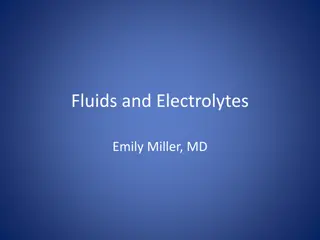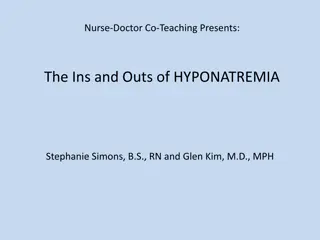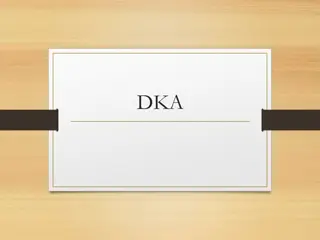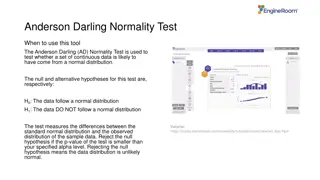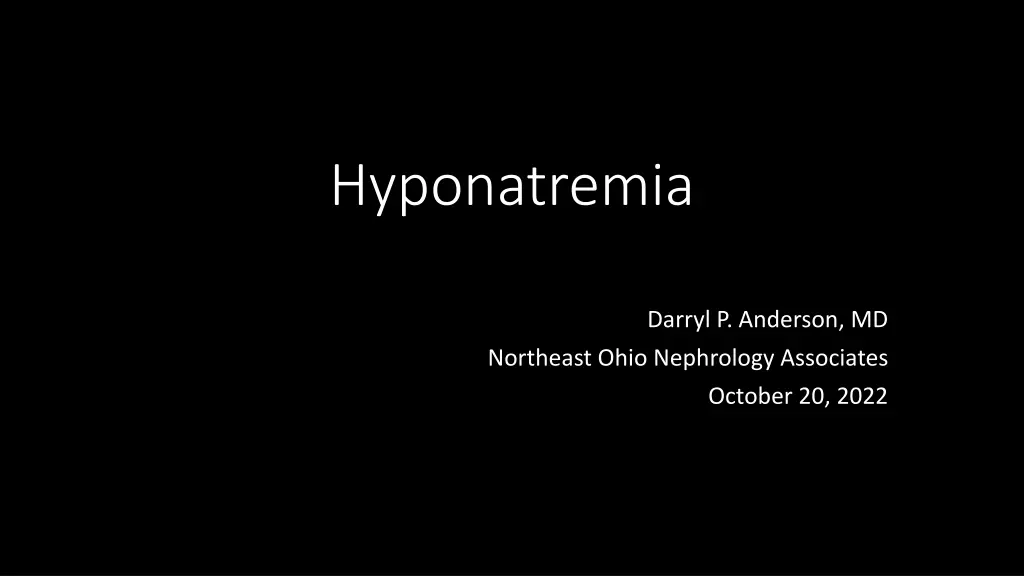
Understanding Hyponatremia: Causes, Symptoms, and Treatment
Explore the physiology, diagnostic approach, and treatment options for hyponatremia. Learn about the key manifestations, including chronic and acute symptoms, and the regulation of osmolality by the pituitary gland. Hyponatremia is a common electrolyte imbalance with significant morbidity and mortality implications.
Download Presentation

Please find below an Image/Link to download the presentation.
The content on the website is provided AS IS for your information and personal use only. It may not be sold, licensed, or shared on other websites without obtaining consent from the author. If you encounter any issues during the download, it is possible that the publisher has removed the file from their server.
You are allowed to download the files provided on this website for personal or commercial use, subject to the condition that they are used lawfully. All files are the property of their respective owners.
The content on the website is provided AS IS for your information and personal use only. It may not be sold, licensed, or shared on other websites without obtaining consent from the author.
E N D
Presentation Transcript
Hyponatremia Darryl P. Anderson, MD Northeast Ohio Nephrology Associates October 20, 2022
Objectives Review physiology of osmoregulation Discuss a diagnostic approach to hyponatremia Review treatment options based on the underlying cause of hyponatremia
Key to Understanding Hyponatremia Serum sodium represents total body WATER content Hyponatremia is an excess of water in relation to sodium Volume status represents total body SODIUM content Hyponatremia can be: Hypervolemic an excess of total body water and sodium Hypovolemic an excess of total body water in a sodium deficient state Euvolemic an excess of total body water with normal total body sodium
Hyponatremia is one of the most common electrolyte abnormalities Diagnosed in about 2.5% of hospitalized patients, developing while admitted in about 2/3 of those patients Associated with significant morbidity and is an indicator of increased mortality Fatality rate may increase by as much as 60 times
Clinical Manifestations Brain Adaptation Hyponatremia causes all cells to take on water and swell Astrocytes will expel electrolytes over 6 to 12 hours Expel organic osmolytes (glutamine and taurine) over 24 to 48 hours
Clinical Manifestations - Chronic Chronic Mild to Moderate: Cognitive impairment and decline Gait instability and falls Osteoporosis and fractures Calcium-forming stones Increased mortality
Clinical Manifestations - Acute Acute Mild to Moderate: Nausea and vomiting Lethargy and confusion Headaches Muscle cramps Acute Profound: Rhabdomyolysis Cerebral edema Seizures Coma Brainstem herniation Neurogenic pulmonary edema
Regulation of Osmolality Pituitary Gland Regulated by action of anti- diuretic hormone (ADH or arginine vasopressin) Produced in the hypothalamus and stored in the posterior pituitary Increased serum osmolality causes shrinkage of the hypothalamic osmoreceptors ADH released into the systemic circulation
Regulation of Osmolality Hypothalamus Thirst induced at serum osmolality of approx. 290 mOsm/kg H20 Does not occur until the urine has reached maximum concentration
Regulation of Osmolality Kidney Collecting duct is generally water impermeable, allowing the production of dilute urine ADH/Vasopressin binds to V2 receptor in the basolateral membrane of principal cells in collecting duct Stimulates translocation and fusion of aquaporin-2 in the apical membrane Reabsorption of water creates a concentrated urine and decreases serum osmolality
Diagnosis of Hyponatremia Classification based on: Tonicity serum osmolality Diagnosis determined by: Volume status urine Na Renal response urine osmolality
Diagnostic Approach to Hyponatremia Because the lab evaluation is often not complete, carefully assessing volume status will give clues to diagnosis and assist in planning initial treatment
Diagnosis of Hyponatremia Isotonic Serum osmolality 275-295 mOsm/kg Hyperlipidemia Paraproteinemia Most measurements assume plasma is 93% water, elevations in lipid or protein concentrations decrease aqueous contribution Hypertonic Serum osmolality > 295 mOsm/kg Hyperglycemia Mannitol Hyperosmolar radiocontrast Correction for hyperglycemia: Corrected Na = Serum Na + [1.6 (glucose 100) / 100] Pseudohyponatremia
Diagnosis of Hyponatremia Hypotonic hypovolemic Hypovolemia Serum sodium low Serum osmolality low Urine osmolality high Urine sodium < 20 mEq/L (usually) Signs/symptoms dry mucous membranes, hypotension, tachycardia, fatigue, headache, dizziness, muscle cramping Most commonly due to intravascular volume depletion Hemorrhage Gastrointestinal losses Excessive diaphoresis Burns Diuretics (urine Na may be > 20 mEq/L early) Less commonly may see salt-wasting (urine Na high) from adrenal crisis (glucocorticoid and mineralocorticoid deficiencies) or cerebral salt-wasting
Diagnosis of Hyponatremia Hypotonic hypervolemic Hypervolemia Serum sodium low Serum osmolality low Urine osmolality high Urine sodium < 20 mEq/L Signs/symptoms hypoxia, hypertension, rales, edema, ascites Most commonly due to decreased effective circulating volume Decompensated heart failure Cirrhosis Nephrotic syndrome Severe hypoalbuminemia
Diagnosis of Hyponatremia Hypotonic euvolemic Euvolemia Serum sodium low Serum osmolality low Urine osmolality high or low Urine sodium > 20 mEq/L Signs/symptoms hypoxia, hypertension, rales, edema, ascites Key is to assess if urine concentration is appropriate
Diagnosis of Hyponatremia Hypotonic euvolemic Appropriate Dilution: Urine Osmolality < 100 mOsm/kg Maximal dilution of urine can reach approx. 50 mOsm/kg Assuming a typical diet creating approx. 800 mOsm solute, the kidneys can produce approx. 16 liters per day of electrolyte free water Hyponatremia results from ingestion of water volumes that exceed excretory capacity Psychogenic polydipsia due to ingestion of excessive water volume Beer potomania/ Tea-and-toast diet of limited solute diminishes excretory capacity (approx. 200 mOsm/day leads to 4 liters per day of maximally dilute urine)
Diagnosis of Hyponatremia Hypotonic euvolemic Inappropriate Concentration: Urine Osm > Serum Osm Profound hypothyroidism nonosmotic release of ADH due to reduced cardiac output Glucocorticoid deficiency loss of inhibition of ADH release SIADH Most common Often with low serum uric acid and BUN levels Fall in serum sodium with isotonic fluid administration often diagnostic
Risk of Treatment of Hyponatremia Brain cells may shrink if hypotonic environment corrects faster than they can reaccumulate effective osmoles Osmotic Demyelination Syndrome Dysphagia Dysarthria Spasticity Behavioral disturbance Cognitive impairment Delirium Seizures Quadriparesis Coma Locked-in syndrome
Risk of Treatment of Hyponatremia Acute hyponatremia Known onset < 48 hours No risk for ODS Chronic hyponatremia Duration unknown, assume > 48 hours Asymptomatic correct < 12 mEq/L over 24 hours and < 18 mEq/L over 48 hours Symptomatic correct by 4 to 6 mEq/L over 2 hours, then correct slowly as above
Treatment of Hyponatremia Hypertonic hyponatremia Correct hyperglycemia Administer isotonic fluids often associated volume depletion from glucosuria Hypotonic hypervolemic hyponatremia Fluid restriction Loop diuretic therapy Sodium restriction If above measures fail, can consider V2-receptor antagonist use
Treatment of Hyponatremia Hypotonic hypovolemic hyponatremia Administer isotonic fluids Appropriate hypotonic euvolemic hyponatremia Psychogenic polydipsia restrict fluid intake Beer potomania/ Tea-and-toast administer isotonic fluids These interventions often result in brisk electrolyte-free urinary losses Monitor urine output If needed, can replace electrolyte free water with enteral water or IV D5W Desmopressin can be considered to limit water losses
Treatment of Hyponatremia Inappropriate hypotonic euvolemic hyponatremia Appropriate hormone replacement for hypothyroidism or adrenal insufficiency SIADH Remove potential medications Treat pulmonary/CNS infections Fluid restrict Supplement solute intake: increasing dietary sodium and protein Use NaCl or urea tabs Low dose loop diuretic If above measures fail, can consider V2-receptor antagonist use
Case Presentation 48 year-old woman with diabetes mellitus and hypertension Presents to OSH with 2 weeks of back pain Home medications notable for long-acting insulin and amlodipine Labs notable for serum Na of 122 at presentation, improved with IVF to 133 by time of discharge Likely cause of hyponatremia? Acetaminophen, cyclobenzaprine, and oral steroids added to regimen
Case Presentation Presents to ED with ongoing back pain despite medications and new right facial droop (Bell s palsy) History notable for living in forested area and tick bite last summer Presumptive diagnosis of neurologic Lyme disease, started on doxycycline Labs notable for serum Na of 128 with serum glucose of 276 Serum Na improved to 130 (serum Osm 280, urine Na 47) with IVF on recheck 12 hours later Next AM, serum Na is 123 What labs should be checked?
Case Presentation Serum Na 123 Serum Osm 272 Diagnosis? What happened? Urine Na 140 Urine Osm 685 How should this be treated?
Case Presentation Started 1200 mL fluid restriction Serum sodium improved to 132 and stabilized with serum osmolality improving to 280- 290s Furosemide 10 mg daily added Avoided NaCl tabs due to HTN to limit sodium loading Why is her sodium still low?
Case Presentation Started 1200 mL fluid restriction Serum sodium improved to 132 and stabilized with serum osmolality improving to 280- 290s Furosemide 10 mg daily added Avoided NaCl tabs due to HTN to limit sodium loading Why is her sodium still low? Serum glucose consistently > 300, corrected Na in mid-130s
Case Presentation Final Diagnoses: Initial hypovolemic hyponatremia, likely due to volume depletion from decreased oral intake +/- glucosuria from hyperglycemia Underlying SIADH secondary to neuroborreliosis Confounding pseudohyponatremia due to persistent hyperglycemia



